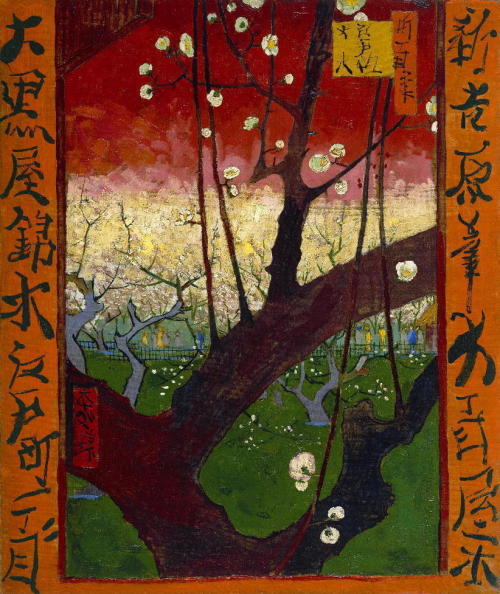#flowering plum tree
MWW Artwork of the Day (4/8/16)
Vincent Van Gogh (Dutch, 1853-1890)
Japonaiserie: Flowering Plum Tree [after Hiroshige] (July-Sept. 1887)
Oil on canvas, 55 x 46 cm.
Van Gogh Museum, Amsterdam
At the Paris World Fair of 1867 Japanese culture burst upon the European scene with the force of a megaton bomb. Kimonos and bamboo screens became all the rage; Parisian ladies turned the tea ceremony into a competitive sport; Japanese woodblock prints appeared in every corner shop and were greedily snatched up by a public infected with “la fièvre japonaise.”
A few decades later, when the fever had subsided and the novelty had wore thin, an influential French critic, looking back over the phenomenon, declared that Japan had invigorated modern art in the same way that classical antiquity had the Renaissance. And the artist upon whom it had the most profound effect was Vincent van Gogh. As early as 1885 in Antwerp he started a collection of Japanese ukiyo-e prints, which by 1887 numbered in the hundreds. His enthusiasm went well beyond collecting: in spring 1887 he organized an exhibition of Japanese prints at the Cafe Tambourin, and that summer copied three prints, two by Hiroshige, in his personal collection. (Copying other works was the artistically unschooled Van Gogh’s method of learning.) Suddenly, the muted color palette of his Paris period brightened, previously shunned black-white contrasts appeared, the daring diagonals and jolting shifts in perspective of the prints found their way into his repertoire. Only one thing remained for Van Gogh, who never did anything in half-measures: he must “find his own Japan.” So he went to Arles, and the rest is, as they say, history.
This painting is a copy of a print in Hiroshige’s last collection, “One Hundred Famous Views of Edo.”
The MWW already contains a substantial number of works by Van Gogh in five separate exhibits, which include ALL his extant paintings, as well a selection of his drawings from each period. Extracts from Van Gogh’s literate and very revealing letters to his brother Theo accompany the pictures, along with the usual background information gleaned from many sources.
* Van Gogh in Holland (Oct. 1881-Feb. 1886)
* Van Gogh in Paris (March 1886-Jan. 1888)
* Van Gogh at Arles (Feb. 1888-April 1889)
* Van Gogh at St.-Rémy (May 1889-May 1890)
* Journey’s End: Van Gogh at Auvers (20 May-29 July 1890)
Post link

